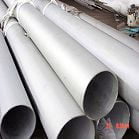What are the differences between 1.4571 and 1.4401 stainless steel?
1.4571 is a grade of austenitic stainless steel, also known as AISI 316Ti or European EN 1.4571. It is a titanium-stabilized version of 1.4401 (AISI 316) and has similar properties, such as excellent corrosion resistance and high strength. The chemical composition of 1.4571 stainless steel is as follows:
Table of Content
隐藏
– Carbon (C): 0.08% max
– Silicon (Si): 1.00% max
– Manganese (Mn): 2.00% max
– Phosphorus (P): 0.045% max
– Sulfur (S): 0.015% max
– Chromium (Cr): 16.50 – 18.50%
– Nickel (Ni): 10.50 – 13.00%
– Titanium (Ti): 5x(C+N) – 0.70% max
The addition of titanium to 1.4571 stainless steel stabilizes the material against sensitization and intergranular corrosion that can occur during welding or at high temperatures. This material is commonly used in applications such as chemical and petrochemical processing equipment, medical implants, and heat exchangers.
1.4571 stainless steel is also known for its good welding and forming properties, making it suitable for use in fabrication and welding processes. However, care should be taken when welding to avoid the formation of brittle phases and intergranular corrosion in the heat-affected zone.
It is worth noting that 1.4571 stainless steel has a slightly lower temperature resistance compared to 1.4401 stainless steel due to the lower carbon content and the presence of titanium.
1.4571 and 1.4401 stainless steels are both austenitic stainless steels that have excellent corrosion resistance and high strength. However, there are some differences between these two materials:
1. Titanium content: 1.4571 stainless steel contains titanium, whereas 1.4401 stainless steel does not. The addition of titanium in 1.4571 stainless steel stabilizes the material against sensitization and intergranular corrosion that can occur during welding or at high temperatures.
2. Carbon content: 1.4571 stainless steel typically has a slightly lower carbon content compared to 1.4401 stainless steel. This results in slightly lower temperature resistance for 1.4571 stainless steel.
3. Applications: 1.4401 stainless steel is commonly used in a wide range of applications such as chemical and petrochemical processing equipment, food processing equipment, and medical implants. 1.4571 stainless steel is often used in applications where sensitization and intergranular corrosion are concerns, such as chemical and petrochemical processing equipment, heat exchangers, and welded structures.
4. Machinability: Due to the presence of titanium, 1.4571 stainless steel can be more difficult to machine compared to 1.4401 stainless steel.
5. Availability: 1.4401 stainless steel is more commonly available and used compared to 1.4571 stainless steel.
In summary, the main difference between 1.4571 and 1.4401 stainless steel is the presence of titanium in 1.4571 stainless steel, which provides added corrosion resistance and stability against sensitization and intergranular corrosion.

